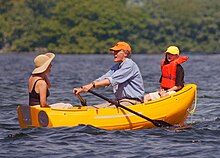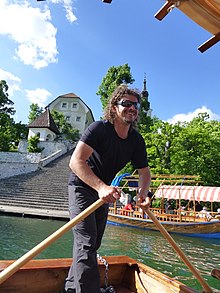
Rowing, sometimes called crew in the United States, is the sport of racing boats using oars. It differs from paddling sports in that rowing oars are attached to the boat using oarlocks, while paddles are not connected to the boat. Rowing is divided into two disciplines: sculling and sweep rowing. In sculling, each rower holds two oars, one in each hand, while in sweep rowing each rower holds one oar with both hands. There are several boat classes in which athletes may compete, ranging from single sculls, occupied by one person, to shells with eight rowers and a coxswain, called eights. There are a wide variety of course types and formats of racing, but most elite and championship level racing is conducted on calm water courses 2 kilometres (1.2 mi) long with several lanes marked using buoys.

A dinghy is a type of small boat, often carried or towed by a larger vessel for use as a tender. Utility dinghies are usually rowboats or have an outboard motor. Some are rigged for sailing but they differ from sailing dinghies, which are designed first and foremost for sailing. A dinghy's main use is for transfers from larger boats, especially when the larger boat cannot dock at a suitably-sized port or marina.
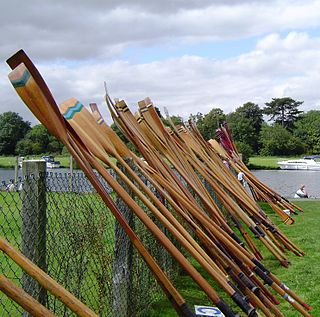
An oar is an implement used for water-borne propulsion. Oars have a flat blade at one end. Rowers grasp the oar at the other end.

An outrigger is a projecting structure on a boat, with specific meaning depending on types of vessel. Outriggers may also refer to legs on a wheeled vehicle that are folded out when it needs stabilization, for example on a crane that lifts heavy loads.
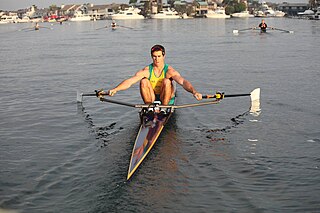
Sculling is the use of oars to propel a boat by moving them through the water on both sides of the craft, or moving one oar over the stern. A long, narrow boat with sliding seats, rigged with two oars per rower may be referred to as a scull, its oars may be referred to as sculls and a person rowing it referred to as sculler.

A gig is a type of boat. It was optimised for speed under oar, but usually also fitted with a sailing rig for appropriate conditions. The type was in use by Deal boatmen in the 18th century. It first occurred as a naval ship's boat after Deal boatbuilders recommended a different design to boats ordered from them by the Royal Navy to equip the cutters purchased in the 1760s to combat smuggling. The captains of larger warships soon sought permission to substitute a gig for one of the heavier boats which were then used; some even had a gig built at their own expense. The gig therefore became part of the usual complement of ship's boats used in warships.

In watercraft, a racing shell is an extremely narrow, and often comparatively long, rowing boat specifically designed for racing or exercise. It is equipped with long oars, outriggers to hold the oarlocks away from the boat, and sliding seats. The boat's long length and semicircular cross-section reduce drag to a minimum. This makes the boat both fast and unstable. It must be balanced by the rowers to avoid tipping. Being able to balance – or "set" – the boat while putting maximum effort into the oars is therefore an essential skill of sport rowing.
In competitive rowing, the following specialized terms are important in the corresponding aspects of the sport:
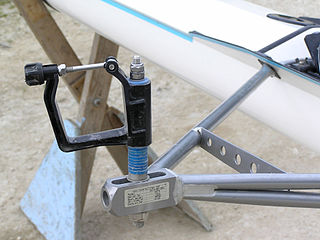
A rowlock, sometimes spur, oarlock or gate, is a brace that attaches an oar to a boat. When a boat is rowed, the rowlock acts as a fulcrum for the oar.

Harry Clasper was a professional rower and boat builder from Tyneside in England. He was an innovative boat designer who pioneered the development of the racing shell and the use of outriggers. He is said to have invented spoon-shaped oars.

In rowing, oars are used to propel the boat. Oars differ from paddles in that they use a fixed or sliding fulcrum, an oarlock or rowlock attached to the side of the boat, to transfer power from the handle to the blade, rather than using the athlete's shoulders or hands as the pivot-point as in canoeing and kayaking.

In rowing, the stroke is the action of moving the oar through the water in order to propel the boat forward. The two fundamental reference points in the stroke are the catch where the oar blade is placed in the water, and the extraction where the oar blade is removed from the water. After the blade is placed in the water at the catch, the rower applies pressure to the oar levering the boat forward which is called the drive phase of the stroke. Once the rower extracts the oar from the water, the recovery phase begins, setting up the rower's body for the next stroke.
Boats used in the sport of rowing may be adjusted in many different ways according to the needs of the crew, the type of racing, and anticipated rowing conditions. The primary objective of rigging a boat is to accommodate the different physiques and styles of rowing of the crew in such a way that the oars move in similar arcs through the water, thus improving the crew's efficiency and cohesiveness.

A thwart is a part of an undecked boat that provides seats for the crew and structural rigidity for the hull. A thwart goes from one side of the hull to the other. There may be just one thwart in a small boat, or many in a larger boat, especially if several oarsmen need to be accommodated.
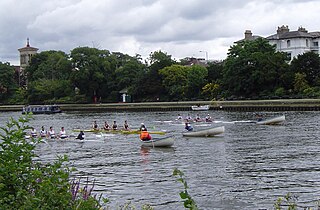
A coxed four, abbreviated as a 4+, is a racing shell used in the sport of competitive rowing. It is designed for four persons who propel the boat with sweep oars and is steered by a coxswain.
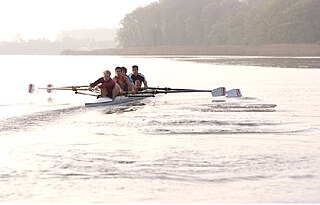
A coxless four, abbreviated as a 4- and also called a straight four, is a racing shell used in the sport of competitive rowing. It is designed for four persons who propel the boat with sweep oars, without a coxswain.

Sweep rowing is one of two disciplines of the sport of rowing. In sweep rowing each rower has one oar, usually held with both hands. As each rower has only one oar, the rowers have to be paired so that there are equal numbers of oars on each side of the boat. In the United Kingdom, rowing generally refers to sweep rowing only. The term pulling was also used historically. In the other rowing discipline, sculling, each rower holds two oars, one in each hand.

Fórcola is the typical Venetian rowlock providing a variety of fulcrum positions, each having its own effect on the rower's oar.

Human-powered watercraft are watercraft propelled only by human power, instead of being propelled by wind power or an engine.

Stern sculling is the use of a single oar over the stern of a boat to propel it with side-to-side motions that create forward lift in the water. The strict terminology of propulsion by oar is complex and contradictory, and varies by context. Stern sculling may also simply be referred to as "sculling", most commonly so in a maritime situation. In fresh water, and particularly in sport rowing, sculling is use of two oars on either side of the boat by each person, in contrast to sweep rowing, whereby each boat crew member employs a single oar, complemented by another crew member working on the opposite side with their oar.
